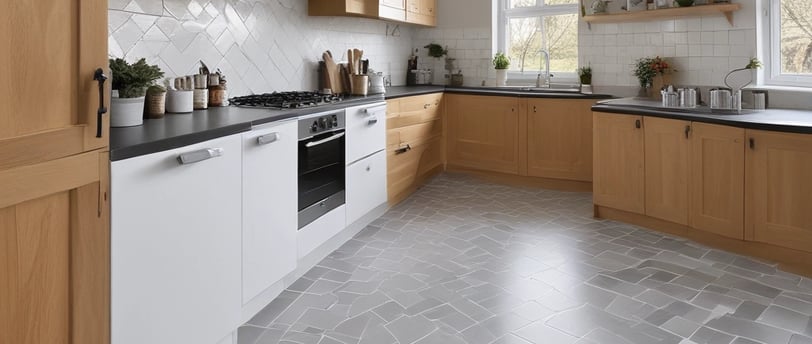Tiling Kitchen Backsplash: Where Functionality Meets Everyday Art
It’s a permanent installation in the most used room of the house. Yet, tiling kitchen backsplash with color is also an opportunity to elevate the emotional temperature of the kitchen
WALL TILES
7/7/20256 min read


Tiling kitchen backsplash might sound like a simple design task at first glance, but once you start exploring its creative possibilities, it becomes clear: this modest stretch of wall is one of the most expressive, practical, and transformative design elements in the entire kitchen. Far from being just a shield against sauce splatter or steam, the kitchen backsplash is a design statement, a tactile focal point, and a canvas where form and function come together in ways both subtle and bold.
Whether you're remodeling a decades-old kitchen or designing a new one from scratch, tiling kitchen backsplash is often one of the final touches. Yet paradoxically, it's a finishing detail that can define the room’s entire personality. A backsplash can bridge styles, unite disparate elements, or offer a burst of contrast in an otherwise monochrome space. It speaks to the aesthetic DNA of the kitchen—telling a story about materials, colors, and textures, but also about lifestyle and the rituals of daily life.
From Shield to Showcase
The original purpose of the kitchen backsplash was strictly utilitarian: protect the wall behind the sink and stove from water, grease, and food stains. It was often a narrow band of tile, installed as a functional afterthought. But over the past few decades, tiling kitchen backsplash has evolved into a deliberate design act.
Today, the backsplash is often the centerpiece of kitchen design. It’s no longer confined to a few inches above the countertop. Instead, it frequently extends to the bottom of upper cabinets, wraps around windows, or stretches from counter to ceiling. This expanded presence makes it one of the most visible and influential surfaces in the room. The question then becomes not just what to tile, but how to tile it.
A tiled backsplash can set the tone for everything else. A classic white subway tile may suggest timelessness and clarity. A bold Moroccan mosaic implies global sophistication and creativity. A mirrored tile backsplash can add light and glamour, while a handmade ceramic tile in muted tones introduces a sense of warmth and tactility. Each choice changes the mood.
The Emotional Intelligence of Materials
The materials chosen for tiling kitchen backsplash are not just about performance—they’re about emotion. Walk into a kitchen lined with glossy sea-glass-inspired tiles and you might feel calmed, transported to the coast. A backsplash made from matte-finish concrete-look porcelain can invoke feelings of urban minimalism and groundedness.
There’s a psychological effect that surfaces have on us. Smooth, reflective tiles feel clean and clinical. Tumbled stone with rough edges evokes rustic authenticity. Glass tiles, particularly when back-painted or layered, suggest depth and luminosity. Metal tiles, especially when brushed or oxidized, whisper industrial chic.
When tiling kitchen backsplash, homeowners are often guided by more than just visual preference. Touch, atmosphere, and light reaction all play crucial roles. The interplay between tile finish, ambient lighting, and the surrounding cabinetry can dramatically shift the space’s character. A glossy tile paired with under-cabinet LEDs creates sparkle and movement. A honed limestone tile absorbs light for a soft, cocooning effect.
Patterns That Speak in Geometry
Patterns used in tiling kitchen backsplash are often the unsung heroes of kitchen design. While color and material grab initial attention, it’s the layout that quietly holds everything together or delivers a whisper of surprise.
Classic horizontal brick patterns remain a favorite for their visual rhythm and timeless appeal. Yet, there has been a rising interest in less traditional formats. Vertical stacks elongate the space, making ceilings feel higher. Herringbone patterns add motion and artistry, drawing the eye like the gentle ripples of a river.
More adventurous designs may incorporate geometric motifs: triangular tessellations, diamond grids, or even randomized mosaic patterns. These layouts invite a sense of play and unpredictability. Even simple square tiles, when rotated or offset, can create complex and intriguing rhythms.
This is where tiling kitchen backsplash transforms from being a safe choice to a medium of self-expression. Geometry becomes language. It can be bold and declarative or subtle and harmonious, echoing the lines of cabinetry, windows, and architectural detailing.
Color as an Act of Courage or Calm
Color decisions in kitchen backsplashes can often feel daunting, and for good reason. It’s a permanent installation in the most used room of the house. Yet, tiling kitchen backsplash with color is also an opportunity to elevate the emotional temperature of the kitchen.
White and neutral tones have long dominated for their versatility and resale appeal, but richer hues are gaining ground. Deep emeralds, ocean blues, mustard yellows, and even dusky charcoals are becoming part of the modern kitchen palette. These choices bring depth and intimacy, and when paired with natural wood, metal, or stone, they can feel earthy and elegant.
Monochrome tiles in glossy finishes add subtle drama, while patterned tiles with hand-painted motifs can anchor eclectic or vintage design schemes. Some homeowners opt for color blocking—a field of tiles in one bold color that acts almost like a painted wall but with texture and permanence. Others go for tonal gradation, using ombre layouts that shift from light to dark across the backsplash.
The key to color success lies in cohesion. Tiling kitchen backsplash isn't just about the tile in isolation—it’s about how the tile interacts with cabinetry, countertops, flooring, and lighting. Each color must sing in harmony with the rest of the kitchen’s palette.
The Power of Texture in Small Spaces
Texture is one of the most underappreciated dimensions in tiling kitchen backsplash. Especially in small or compact kitchens, where square footage is limited, textured tiles can create depth and visual richness that color alone cannot achieve.
Handmade tiles with uneven surfaces catch the light in unexpected ways. Beveled subway tiles create shadow play that adds dimensionality. Tiles with crackle glaze, tactile ridges, or sculptural profiles introduce a sensory layer that is both visual and haptic.
These subtle shifts in surface not only make the backsplash more engaging but also disguise smudges, fingerprints, and splashes—a welcome trait in hardworking kitchens. Texture, in this sense, is as practical as it is beautiful.
In open-plan homes, a textured backsplash can also serve as a transitional element between kitchen and living areas, softening the hard edges of appliances and cabinetry and helping the space feel more integrated and cohesive.
Mixing Materials, Layering Stories
One of the most sophisticated strategies when tiling kitchen backsplash is to mix materials. This could mean using stone tiles as a central panel above the range, flanked by ceramic field tiles elsewhere. Or it might involve pairing sleek glass tiles with rustic terracotta, metal inlays, or reclaimed wood trims.
This kind of material mixing allows for narrative layering—each surface contributes to a broader story about place, taste, and time. It reflects a nuanced approach to design that doesn’t feel like a showroom display but a lived-in, curated environment.
Layering also offers functional benefits. For example, high-heat or water-prone areas may use impervious tiles, while accent walls can indulge in more delicate or artistic finishes. The result is a kitchen that balances utility with flair, heritage with innovation.
Height, Proportion, and Unexpected Places
When considering tiling kitchen backsplash, many people default to the standard: tile from countertop to the bottom of the upper cabinets. But more ambitious designs are rethinking these boundaries.
Backsplashes that run all the way to the ceiling create a sense of vertical drama and architectural presence. They draw the eye upward and make even modest kitchens feel grand. Tiling around windows, up over range hoods, or even wrapping into niches and open shelving zones expands the visual field.
Another emerging trend is tiling the sidewalls of kitchen alcoves or peninsulas—areas that are adjacent to, but not traditionally considered part of, the backsplash zone. This extension of tile introduces continuity and flow, turning the backsplash from a rectangle into a room-defining feature.
And don't overlook the power of restraint. A single, well-placed tiled backsplash in an otherwise bare wall can function like a framed work of art. With strategic lighting, it becomes the soul of the kitchen.
Practical Wisdom: Installation, Grout, and Longevity
Beyond design, tiling kitchen backsplash requires practical consideration. Installation quality can make or break even the most beautiful tile selection. A poor layout, crooked lines, or inconsistent grout can distract from the intended effect.
Grout color is another unsung hero. Matching grout creates a seamless look, while contrasting grout can define geometry and add graphic precision. Epoxy grouts, while more expensive, offer superior stain resistance and are increasingly favored in kitchens.
Durability is central. Tiles must resist heat, moisture, and cleaning chemicals. Porcelain and ceramic are kitchen workhorses, but even natural stone, when properly sealed, can endure. Maintenance needs should be matched to your lifestyle: a busy family may prefer low-maintenance surfaces, while a design-savvy homeowner might accept a bit more upkeep in exchange for aesthetic impact.
Ultimately, the longevity of a tiled backsplash isn’t just in the material—it’s in its adaptability. Classic layouts and colors can evolve with your style, allowing you to repaint cabinetry or swap hardware without needing a full renovation.
Final Thoughts: Tiling Kitchen Backsplash as an Act of Identity
To tile a kitchen backsplash is to declare something. About who you are, what you love, how you live. It’s a rare opportunity in home design to balance expressive creativity with daily practicality. Unlike a painting you might grow tired of or a fabric that fades, a tiled backsplash remains—often for years or decades—as a testament to your choices.
As you consider tiling kitchen backsplash in your own space, let yourself be guided not just by trends or resale value, but by feeling. What atmosphere do you want to create when you walk into the kitchen? What textures, colors, and shapes speak to your personal sense of beauty? Which stories do you want your kitchen to tell?
In answering those questions, you unlock not just a design solution, but a deeper kind of satisfaction: the joy of shaping space to reflect your inner world. That is the art of the backsplash. That is where tile transcends surface, becoming story.
About
Elijah Tiles is a trusted name in quality tiling services, led by a passionate and highly skilled professional with years of hands-on experience in residential, commercial, and custom tiling projects. We specialize in transforming ordinary spaces into beautiful, functional environments using precise craftsmanship and durable finishes. Whether it's bathroom remodeling, kitchen splashbacks, floor and wall tiling, or decorative mosaic work, Elijah Tiles delivers excellence on every job—big or small.
Services
Contact
info@elijahtiles.com
+35677685882
Elijah Tiles © 2025, All rights reserved.
